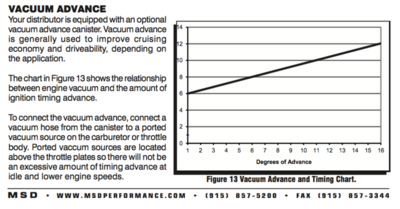So the center carb has a vacuum port on it, that is ported...correct? the port in the attached pic (below the carb) is manifold, correct? Based on what I have been reading, this is where I should connect the port on the distributor (MSD Ready to Run)?
View attachment 702081
The tree at the back of your manifold is "manifold", has vacuum full time at idle. Some carbs have "manifold" if the nipple is below the throttle plate. If the carb has a "ported" nipple it will be above the throttle plate. The "ported" won't have vacuum until you start to open the throttle.
Easy way to tell if you have an adjustable vacuum advance can on your distributor is that it will be six sided not round. Here's a pic why they are six sided. (This one has been cut apart)
As to find out what works for your application, you have to get a timing light hooked up and see just what it's doing. First without any vacuum hooked up, you need to see what the mechanical part of the distributor is doing. Then once you have that figured out and it's what you want, then you can move on to the vacuum advance part of it. You want to see what its doing throughout the whole rpm scale.
Let's say you set your initial at 16* (no vacuum advance hooked up). As you rev the engine the timing mark will start advancing. When it stops advancing make note of where and what rpm. Lets say 34* at 2500 rpm. Thats your "all in" at 2500 rpm.
Now hook up you vacuum can to what ever you want to try (ported or manifold). On ported you will probably see your initial 16* at idle and while revving the engine you'll see the "all in" 34* at 2500 rpm, then as you go past that rpm you'll see the vacuum advance come in and it might go almost off the scale. Ideal would not be past 50-55*. If it goes past that you'll need to adjust the vacuum advance to limit it to 50-55*. Just an example of what you might find when first setting things up with ported vacuum advance.
Hooking the vacuum advance to manifold will be different because the advancement is made right after the engine starts. Set your initial without vacuum hooked up, check your all in. Then hook up the vacuum advance and see how it acts throughout the rpm range.
Like Bill Monk said, you have to experiment with both and see what works for your set-up.
My 440 with dual 4bbl doesnt like manifold at all. I've tried to get it to work but it just won't. My conclusion is that I have too much vacuum with my cam. If it was a lumpier cam with low vacuum then manifold might work. Jmo
Take your time and get familiar with whats going on. It's a lot to get your head around at first. Good luck.


















